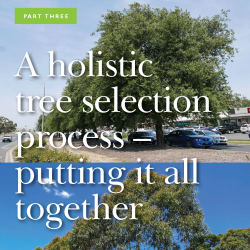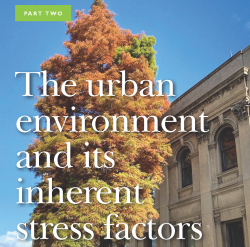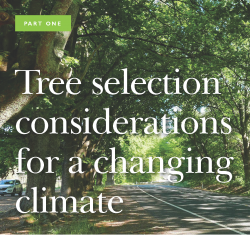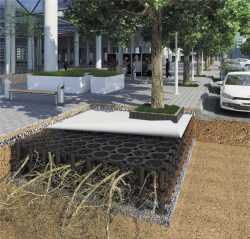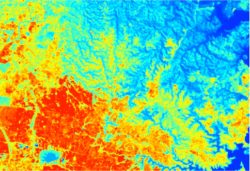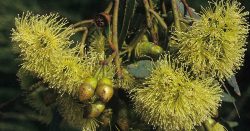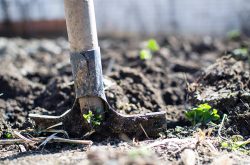-
A holistic tree selection process – putting it all together
September 16, 2020 at 2:04 amPart 3 of the Tree selection considerations for a changing climate series by Stephen Frank and Kirsten Raynor explores the tree selection process using climate suitability modelling, plant traits and physiology, and the effects of the urban environment on tree growth. It also discusses methods for the trialing and monitoring of plant performance in the landscape. There are many factors to consider when selecting trees for urban forests. This has become even more complex with the predicted changes to future…
Read More -
The urban environment and its inherent stress factors
September 1, 2020 at 5:53 amPart two of the climate change series by Stephen Frank and Kirsten Raynor will explore the constraints on plant performance caused by the urban environment. The latest article explores adaptive management and research enabling sustainable urban tree selections. Planting the right tree in the right location is a common theme. There are many factors to consider when selecting trees for urban forests. This has become even more complex with climate change and the adaptations required for predicted changes to growing…
Read More -
Tree selection considerations for a changing climate
August 25, 2020 at 12:11 amPlanting the right tree in the right location is a common theme. There are many factors to consider when selecting trees for urban forests. This has become even more complex with climate change and the adaptations required for predicted changes to growing conditions. Treelogic director Stephen Frank and colleague Kirsten Raynor have written a series of articles that combine current research and careful thought to aid with the selection of trees in a changing climate. PDF: Part 1 - Tree…
Read More -
The interceptors: an urban watershed solution for climate change resistance
June 17, 2020 at 1:54 amFresh water is a finite resource, so a water tanker leaving Hepburn Shire every four hours is becoming quite a drain. With many regions affected by recent droughts and bushfires, it seems strange that 80 million litres of Australia’s water is bottled and shipped off each year (Elg, 2019). The sustainability of global ground water is a concerning issue as climate changes and rain events become more unpredictable. Urban environments rely on a matrix of impervious concrete pipes and channels…
Read More -
Working together to cool the hottest parts of our cities
September 30, 2019 at 7:29 amHow do we reduce the effects of our Urban Heat Islands? As our summers get hotter and hotter, it’s more important than ever to consider how we manage heat accumulation. Over the next decades, our lives may depend on mitigating the effects of heat transfer in our public spaces. Urban Heat Islands (UHIs) are highly populated constructions that acquire and retain heat from the daylight hours long into the night. Significant elevations in temperature are charted across urban zones, with…
Read More -
A great Autumn tree to consider
April 22, 2019 at 11:54 pmAn oldie but a goodie. Stephen from Tree Logic discusses the virtues of the Autumn Blaze Maple, an outstanding tree!
Read More -
Reading the (tree) leaves
March 20, 2019 at 11:32 pmHow can we predict how our urban trees will perform into the future? Most young trees look great in the nursery. While tree stock are well-watered and cared for, this is not necessarily the best indicator of what will thrive for decades after planting. With increased extreme weather events leading to even more stress on our trees, monitoring and forecasting tree performance must become a vital part of urban planning and development. Street trees are often selected according to availability,…
Read More -
At Ground Level
August 5, 2018 at 11:42 pmWhy urban soil isn’t as healthy as it looks – and what you can do about it. In urban areas, our soil isn’t as healthy as it looks. Whereas once leaves would recycle and create nutrients for the topsoil, the natural cycles are now broken. Issues such as compaction and man-made materials can affect growing conditions and hold our trees and plants back from flourishing. The essential element of developing healthy gardens is right under our feet yet is often…
Read More -
World’s tallest hardwood tree, found in Tasmania
July 31, 2017 at 1:18 amWhat is believed to be the world’s tallest hardwood tree has been discovered near Forestry Tasmania’s Tahune Airwalk tourism attraction 88km south of Hobart. One of two giant Mountain Ash (Eucalyptus regnans) found growing together, the trees were detected in August using an airborne Light Detection and Ranging Laser scanning technology (LiDAR). The trees were subsequently located and inspected from the ground where their heights were measured. Details of the two trees are as follow: Name: Centurion Height: 100 –101…
Read More -
Trees and Bushfires
July 31, 2017 at 12:48 amApart from the potential human tragedy and loss, bushfires often result in a temporary loss of landscape amenity. Following bushfires there is often apprehension by those directly affected about replanting trees adjacent to homes and other buildings. The benefits of trees in our landscapes are significant and well documented. The use of fire retardant trees in areas prone to bushfires can not only add beauty to our gardens but, when selected and placed appropriately, fire retardant trees can assist in…
Read More -
The benefits of trees: shade
July 31, 2017 at 12:46 amWhen the sun beats down on concrete, bitumen, and bricks these materials store the heat (they have high thermal mass) and continue to release that heat when the temperature cools. So in heat waves, it’s not just the temperature created by the sun during the day that makes us hot, it’s also the heat released from high thermal mass materials, which can occur for several hours, even days. The solution – don’t let them get hot in the first place…
Read More -
Right tree, right place, right way, and right time
July 31, 2017 at 12:41 amTrees are the dominant component in landscapes and one of the most effective ways of improving the image and landscape character is to plant trees in open space. But not all trees are compatible for every planting site or in every climate. Tree selection and placement are two of the most important decisions to make when planting trees. Many trees have the potential to outlive those who plant them, so the impact of this decision can last a lifetime. You…
Read More -
Docklands Project comes to fruition with Norfolk Island Pine
July 31, 2017 at 12:17 am[video width="1280" height="720" mp4="https://treelogic.com.au/wp-content/uploads/2017/07/43939594.mp4" preload="auto" poster="https://treelogic.com.au/wp-content/uploads/2017/07/Screen-Shot-2017-08-05-at-1.38.54-pm.png"][/video] Docklands project sees the avenue of Norfolk Island Pines finally being planted. Early in March, Tree Logic was onsite at Harbour Esplanade with consultants Brown and Tompkinson, BKK Architects, Taylor Cullity Lethlean and Cut & Fill to witness a long and extensive project take shape. Steve Frank explains why the Norfolk Island Pine was the species of choice for this major Vic Urban Harbourside development. Thanks to all those involved docklands.com: http://www.places.vic.gov.au/precincts-and-development/docklands-victoria Vicurban: http://www.places.vic.gov.au/land-and-housing BKK…
Read More -
Are sharks more dangerous than trees?
July 31, 2017 at 12:12 amEven though trees don’t chase after you when you’re swimming or reach out and grab you when you walk past them, there is a perception in some parts of the community that trees are very dangerous. This view was confirmed recently when Tree Logic was involved in a community survey, designed to ascertain local residents views about trees. One particular respondent took us by surprise stating that ‘trees killed between 30 to 40 people every year’. Further investigation showed that…
Read More
